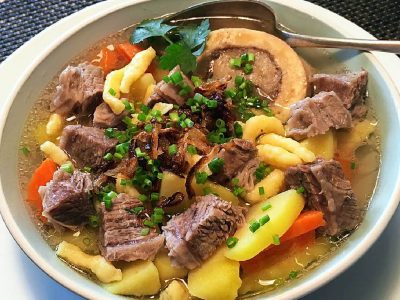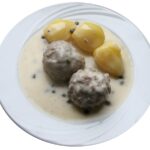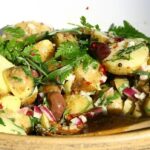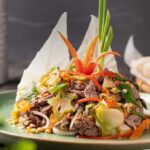 Gaisburger Marsch (German for “march of Gaisburg”) is a traditional Swabian beef stew, named after Gaisburg, a district of Stuttgart. The meat, cooked in a strong beef broth, is cut into cubes and served with cooked potatoes and Spätzle. The broth is poured over the dish before topping with golden-brown onions fried in butter.
Gaisburger Marsch (German for “march of Gaisburg”) is a traditional Swabian beef stew, named after Gaisburg, a district of Stuttgart. The meat, cooked in a strong beef broth, is cut into cubes and served with cooked potatoes and Spätzle. The broth is poured over the dish before topping with golden-brown onions fried in butter.
One explanation for the name Gaisburger Marsch is that the dish was so popular in the 19th century among officer candidates that they marched all the way to Gaisburg where their favorite dish was served in the restaurant called Bäckerschmide. Another version claims that locals from Gaisburg became prisoners of war and their women were only allowed to bring them one meal every day, so they created this nourishing dish and marched with it to the camp. The district of Gaisburg (today part Stuttgart Ost) hosts annual celebrations with a festival lasting several days.
Ingredients:
For the broth
800 g round steak
4 beef broth marrow bones
3 carrots
1 knob celery
1 leek
½ bunch of parsley
1 bay leaf
3 peppercorns
salt
2 liters water
For the Gaisburger Marsch
500 g potatoes
500 g carrots
500 g Spätzle
Garnish
Chives
Parsley
Golden-brown onions fried in butter
Preparation:
- Peel knob of celery and carrots, then roughly cut into 3 cm pieces. Cut leek in quarters and place celery, carrots and leek into a big pot with parsley, bay leaf, peppercorns and add 2 liters of water.
- Wash the beef broth marrow bone and the round steak under cold water then add to the pot.
- Season with salt and bring everything to a boil, then simmer for 2 hours.
- In the meantime, peel potatoes and carrots and cut into 3 cm pieces. Place them into individual pots, cover with water and cook until soft.
- Once the broth is boiled and the meat falls apart, strain out the broth vegetables and the beef broth marrow bones.
- Take out the round steak and cut into bite-size pieces and place back into the broth, together with the carrots, potatoes and Spätzle.
- Bring to a boil and serve hot.
- Garnish with chives and parsley and Golden-brown onions that have been fried in butter







